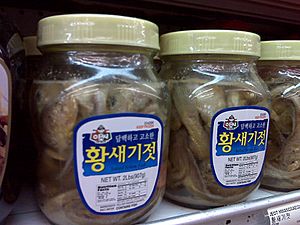Jogi-jeot facts for kids
 |
|
| Alternative names | Salted yellow croaker |
|---|---|
| Type | Jeotgal |
| Place of origin | Korea |
| Main ingredients | Yellow croaker |
| Korean name | |
| Hangul |
조기젓
|
|---|---|
| Revised Romanization | jogi-jeot |
| McCune–Reischauer | chogi-chŏt |
| IPA | [tɕo.ɡi.dʑʌt̚] |
Jogi-jeot (조기젓) is a special Korean food. It's also called salted yellow croaker. This dish is a type of jeotgal, which means it's made from seafood that has been salted and fermented.
Jogi-jeot is made using yellow croaker fish. In Korean cuisine, people enjoy jogi-jeot in many ways. It can be a banchan (a small side dish served with a meal). It's also used as a condiment to add flavor to other foods. Sometimes, it's even an ingredient when making kimchi, a famous Korean fermented vegetable dish.
Contents
The Story of Jogi-jeot
Koreans have been eating yellow croakers for a very long time. This fish has been an important part of their diet for centuries. Ancient records show that yellow croakers were caught and enjoyed in Korea even in the early 2nd century. This tells us that jogi-jeot and similar salted fish dishes have a deep history in Korean food culture.
How Jogi-jeot Is Made
Making jogi-jeot is a careful process that takes time. Here's how it's done:
Choosing the Best Fish
The first step is to pick the right fish. The best yellow croakers are caught between May and June. They should look fresh, have shiny scales, and a nice, full belly.
Salting the Croakers
After washing the fish, they are placed on a sokuri, which is a traditional bamboo tray, to dry. Then, each fish is carefully filled with coarse salt.
Layering in Jars
The salted fish are then placed inside a special onggi (earthenware jar). The jar is first lined with salt. Then, a layer of fish is added, followed by a layer of salt. This layering continues until the jar is about 70% full.
Adding Brine and Fermenting
To keep the fish in place, split bamboo stalks are laid over the top. Then, a mixture of boiled and cooled salt water, called brine, is poured over everything. The amount of salt used should be about 15-20% of the fish's weight.
The jeotgal is then left to ferment. This means it sits and slowly changes over time. It ferments at a temperature of about 15-20 degrees Celsius (59-68 degrees Fahrenheit). This process can take anywhere from two to three months, or even up to a year! This long fermentation gives jogi-jeot its unique and delicious flavor.

